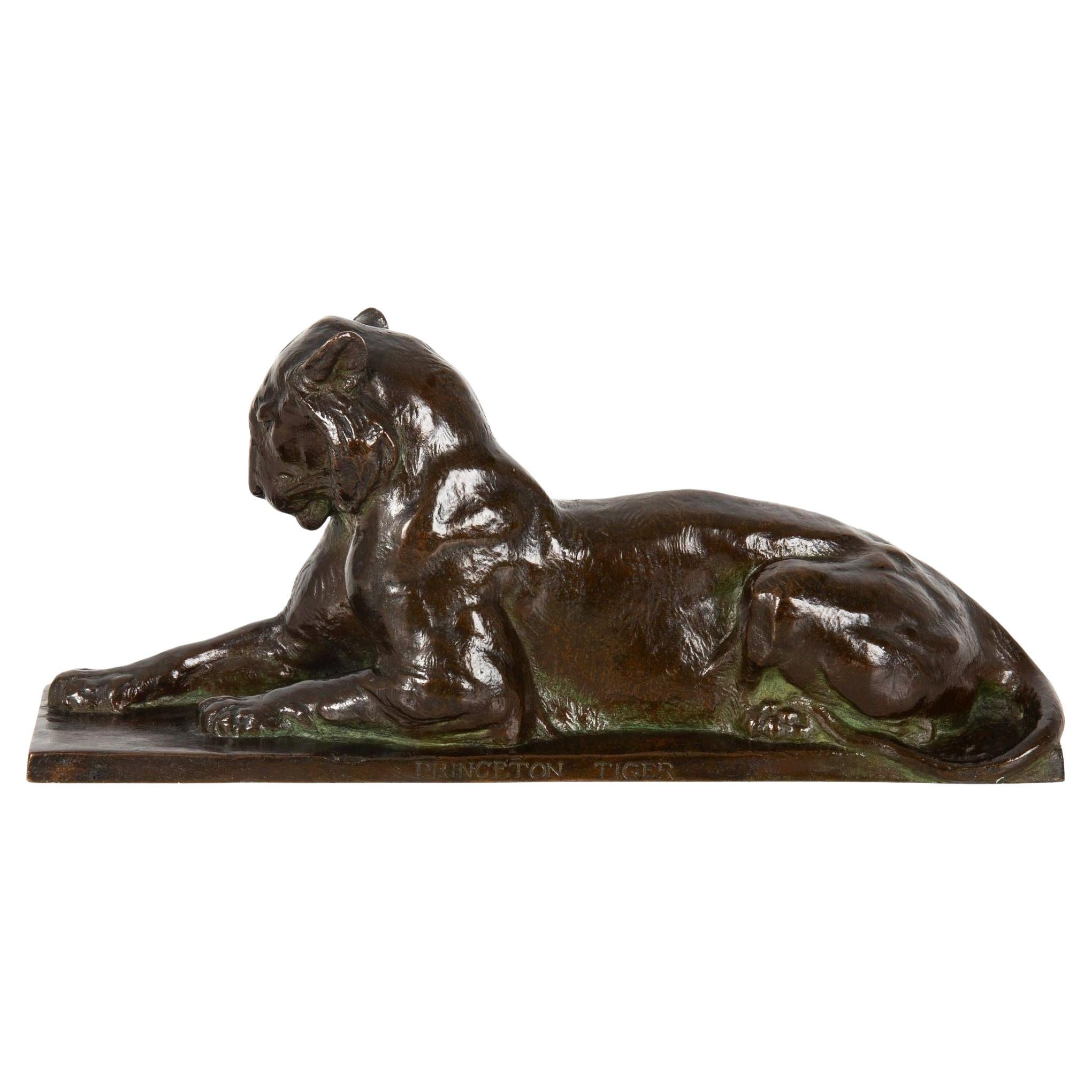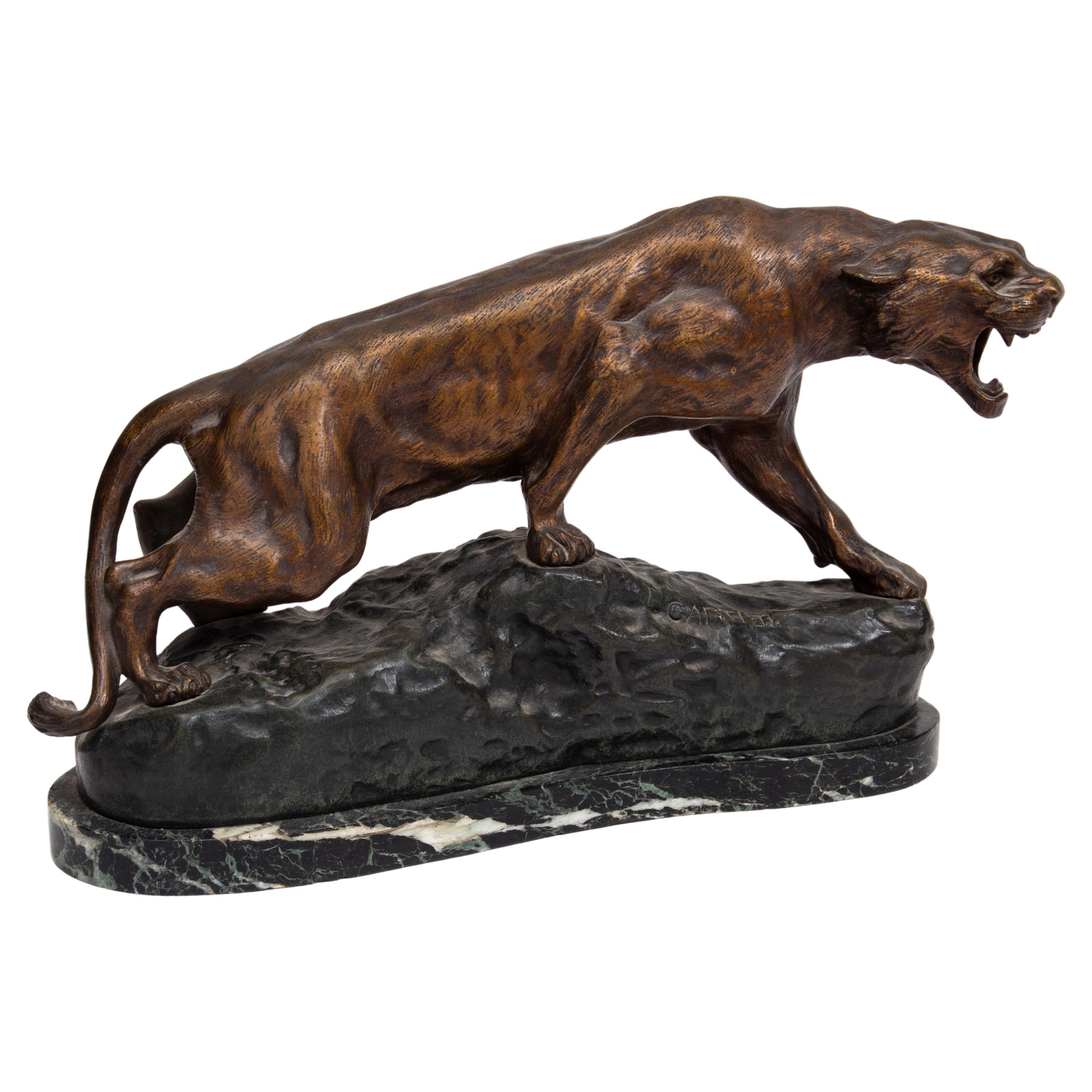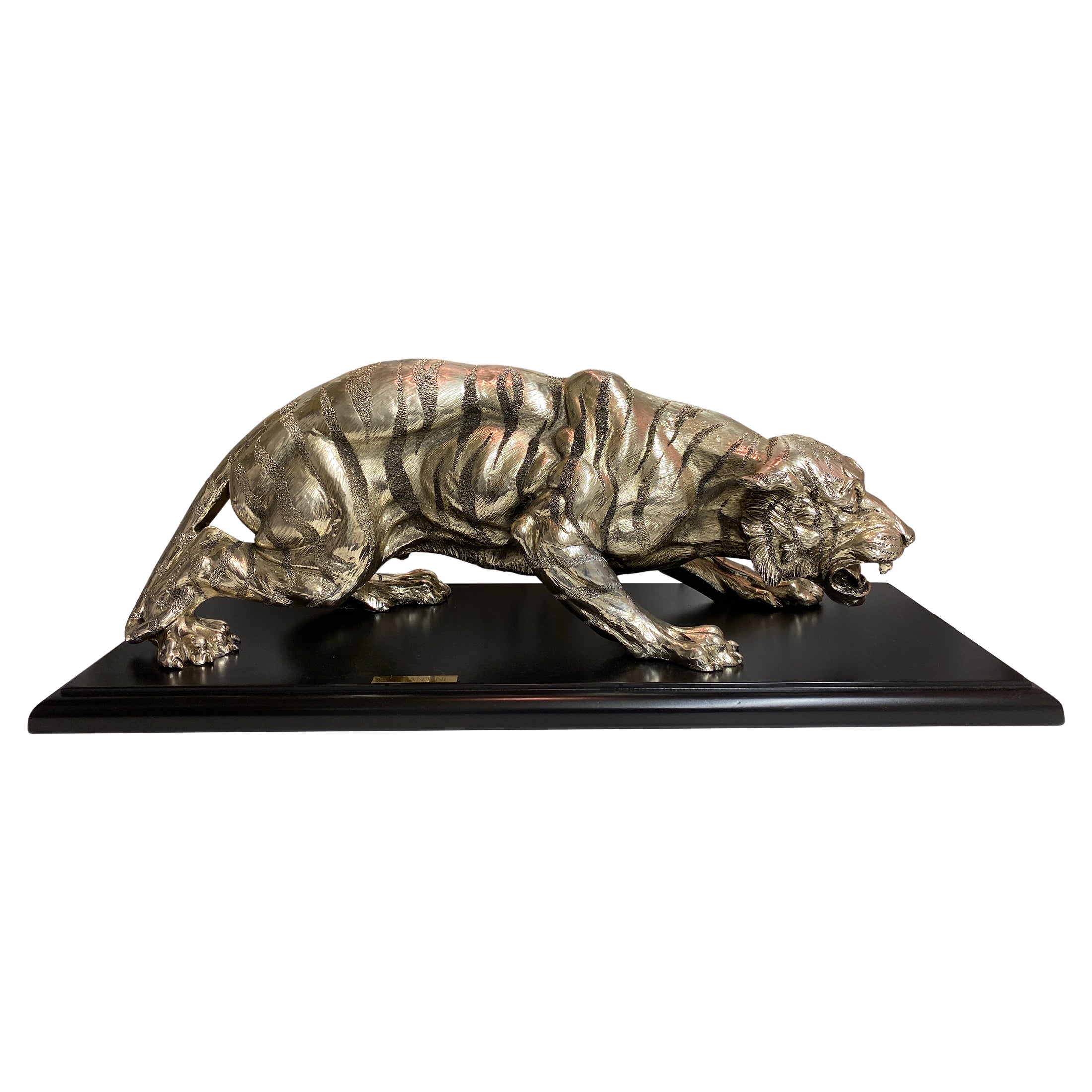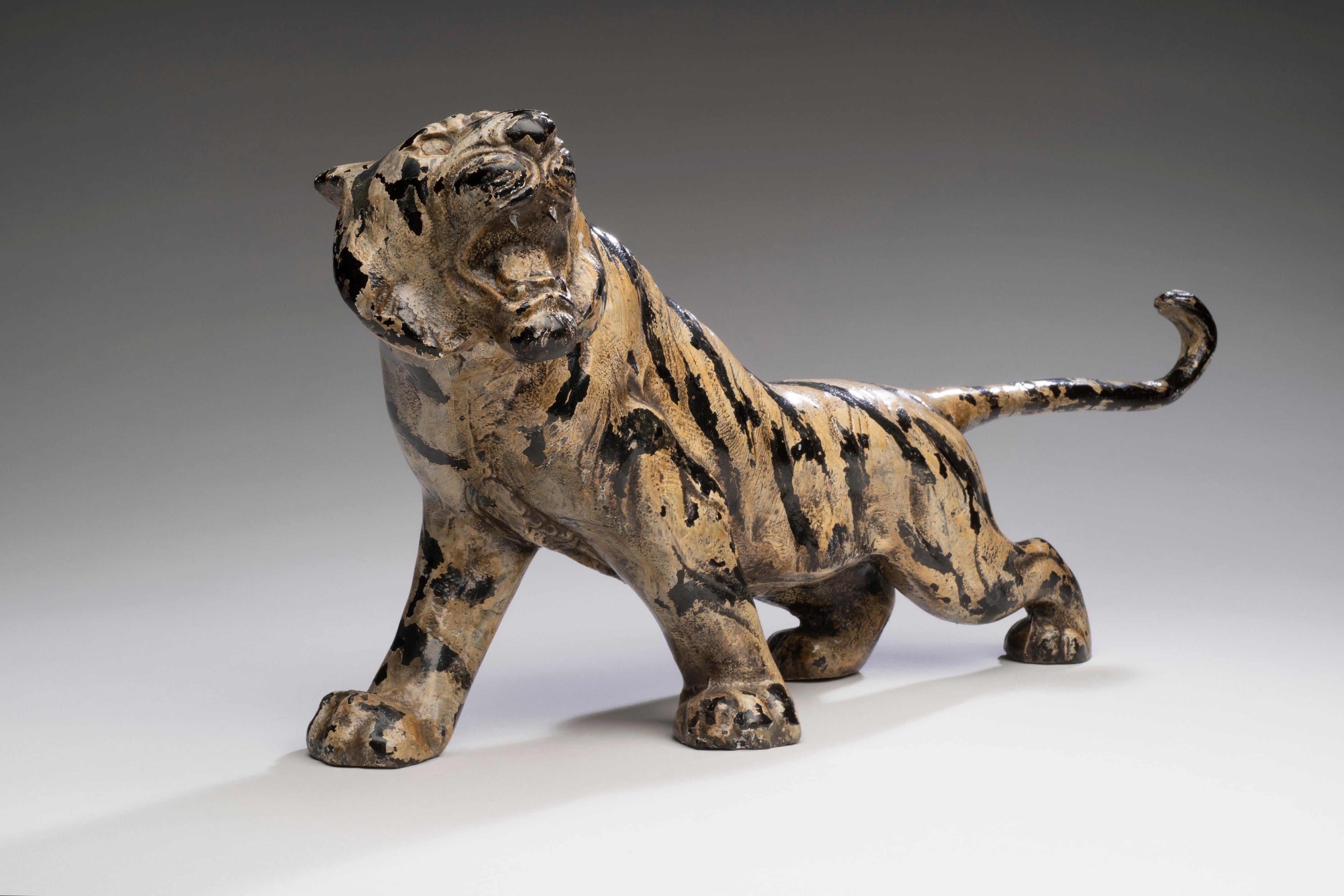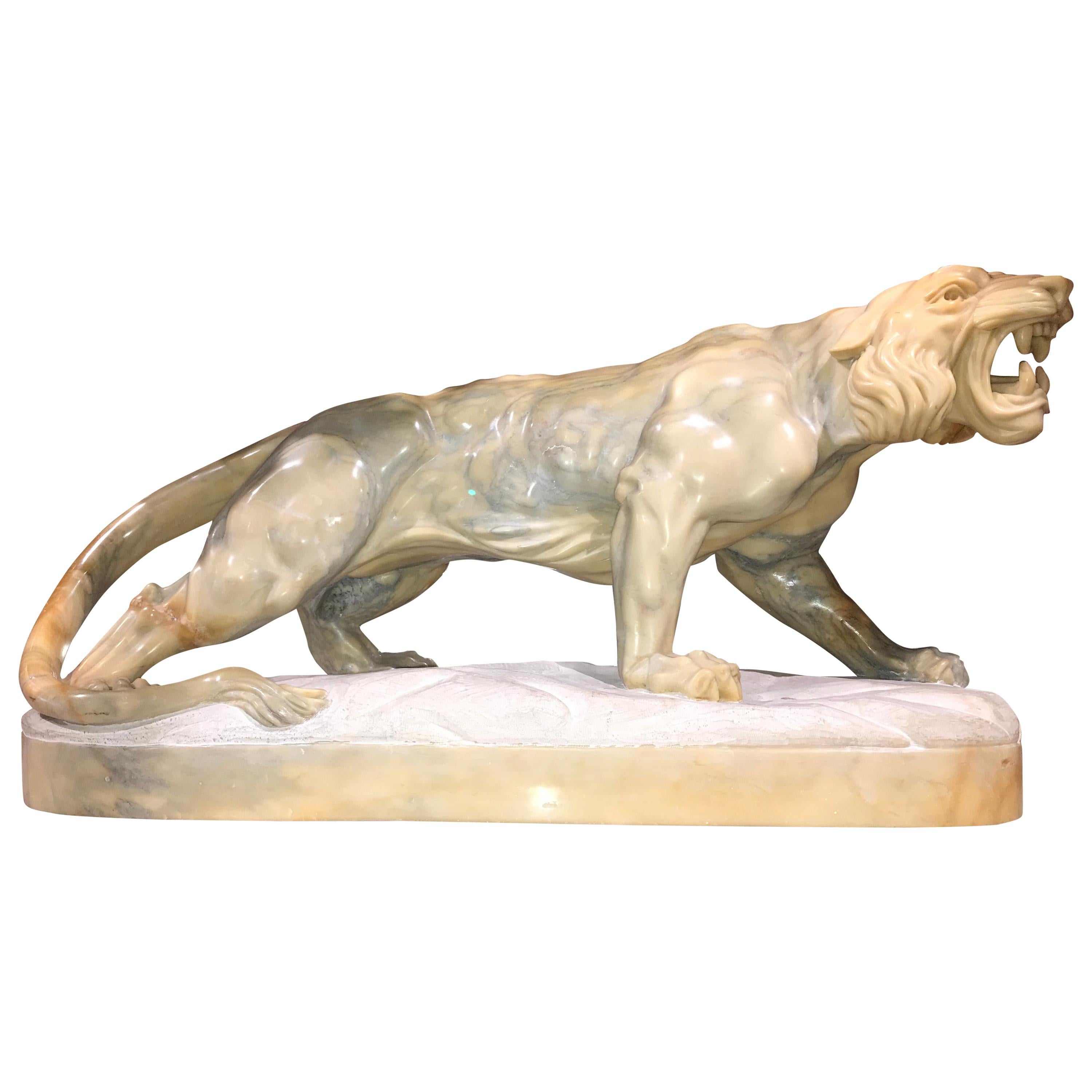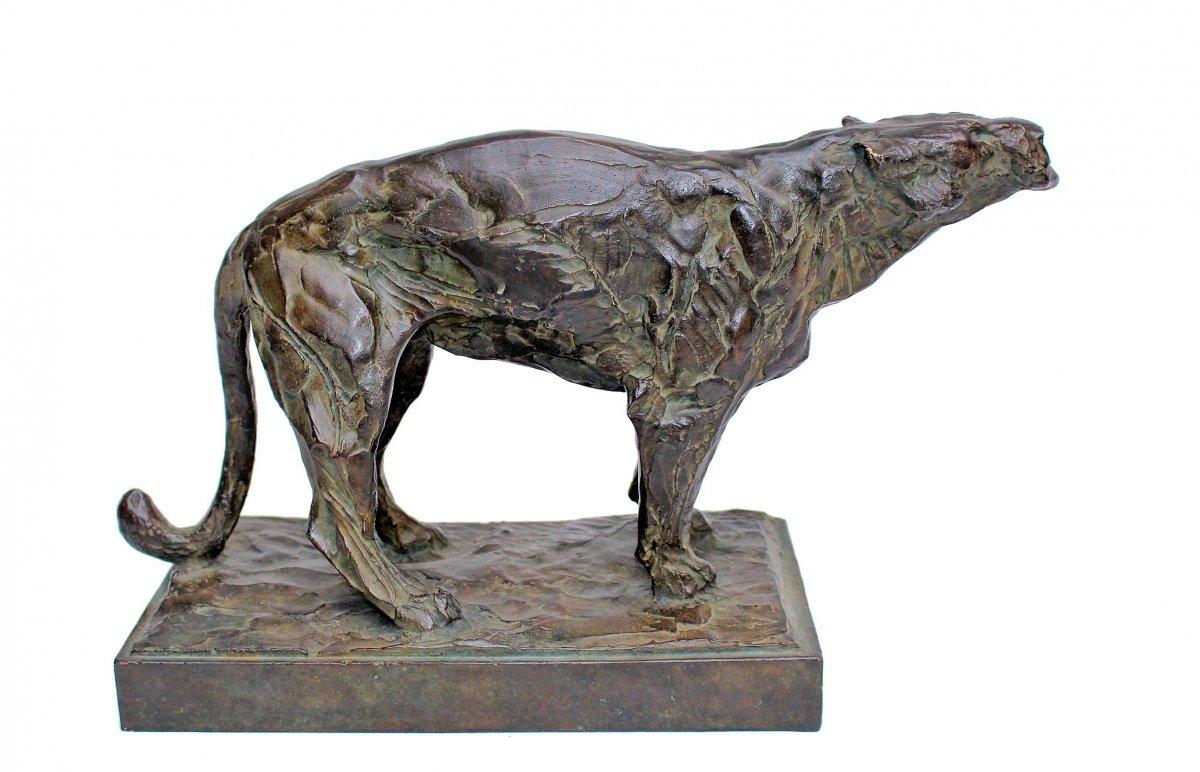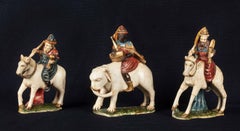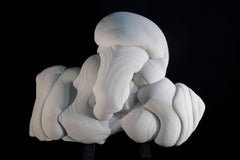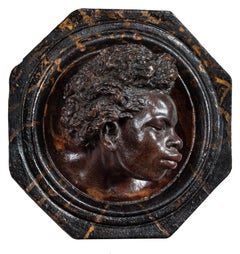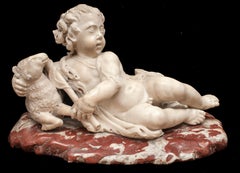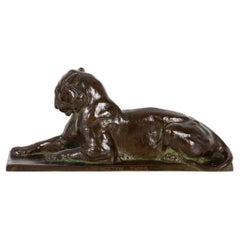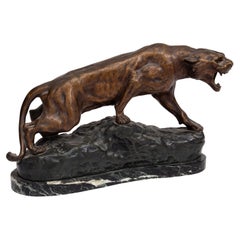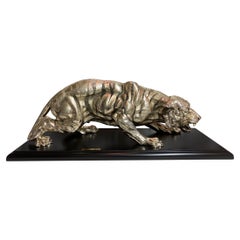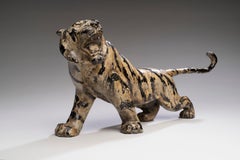Items Similar to The Princeton Tiger
Want more images or videos?
Request additional images or videos from the seller
1 of 7
Charles R. Knight The Princeton Tiger1943
1943
$40,000
£30,811.34
€35,182.94
CA$57,060.84
A$62,413.92
CHF 32,753.30
MX$746,436
NOK 413,344.80
SEK 385,600.80
DKK 262,752
About the Item
Provenance: The artist; thence by descent to his granddaughter:
Rhoda Knight Kalt; from whom acquired by:
Private Collection, Pennsylvania, 1995–2025.
Literature: Richard Milner, Charles R. Knight: The Artist Who Saw Through Time, New York, 2012, p. 63.
Signed and dated at the rear: CHAS. R. KNIGHT / 43
Charles R. Knight holds a unique place among American painters. As much a zoologist as an artist, he is responsible for the authoritative and dramatic images of our ancient past that have inspired generations of students and adults. Beginning in the 1890s, Knight utilized his extensive knowledge of animal anatomy and his ability to capture motion and behavior of living animals, both in zoos and in the wild, in a collaborative effort with paleontologists to visualize and to illustrate antecedents of current species, pre-historic creatures and early man. Knight’s great murals in this genre are to be found in America’s major natural history museums: the Field Museum in Chicago, the Natural History Museum in Los Angeles, and the American Museum of Natural History in New York City.
Knight’s interest and involvement with wild cats was life-long. Sheets of studies record the artist’s fascination with their habits, activities, and behavior—particularly of tigers, which seem to have held a special place in the artist’s life. Paintings and watercolors of tigers included many varieties, both extant and extinct (such as his celebrated depictions of Smilodon).
Knight had for many years dreamed of sculpting a large bronze statue of a tiger to be placed outside of Princeton University’s football stadium to honor the University’s team, the Princeton Tigers. He sculpted Leaping Tiger (Fig. 1) in 1925 with the hope that funds could be raised to place a bronze version of “heroic size,” in the artist’s words, outside of Stephen Palmer Stadium, which had been donated by Edgar Palmer of the Class of 1903. However, despite the support of Knight’s great sponsor and patron, Henry Fairfield Osborn (1857–1935), the project never materialized.
In the 1930s Palmer undertook the commercial redevelopment of the center of the town of Princeton in an area along Nassau Street directly across from the University campus. Colonial Revival buildings were constructed around a public square populated with shops, restaurants, residences, and, prominently, a new Post Office and the rebuilt Nassau Inn.
After Edgar Palmer’s death in 1943 his family commissioned Knight to sculpt a monumental tiger to be placed at the center of Palmer Square, both as an homage to the University’s mascot and as a memorial to Palmer. Unlike the fierce adversary of the 1925 tiger, the Palmer Square tiger would depict the cat in alert repose, in an attitude similar to that of Knight’s 1923 painting The River of Time (Fig. 2), which Osborn had earlier commissioned to decorate the old Nassau Inn.
The present work is the original plaster maquette for the Palmer Square Tiger. First modelled in clay, then cast by the artist in plaster detailed by him, the tiger was then enlarged approximately three times at the Roman Bronze foundry in New York. At over eight feet in length, the finished bronze was dedicated in 1944.
Since then the sculpture has become both a landmark of the town and a symbol of the University—one that resonates with students, alumni, and visitors alike. Writing to Charles R. Knight some years after the sculpture’s dedication, Palmer’s son-in-law commented:
“Some works of art deteriorate with age and take on the appearance of obsolescence—not so however with the Knight Tiger which adorns Palmer Square at Princeton, New Jersey… I had the pleasure of spending yesterday in Princeton, and of… observing it carefully after these years have gone by. I just wanted you to know that it has taken on a dignity which is really inspiring to the people of Princeton, and, of course to the students it is an emblem symbolic of energy, courage, perseverance, and success, not alone in athletics, but in all activities.”
A concrete version of the Palmer Square Tiger, said to have been used in the casting process, descended in Palmer’s family as a garden ornament. In 1983 it was given to the University, restored, and placed in the lobby of Jadwin Gymnasium at Princeton.
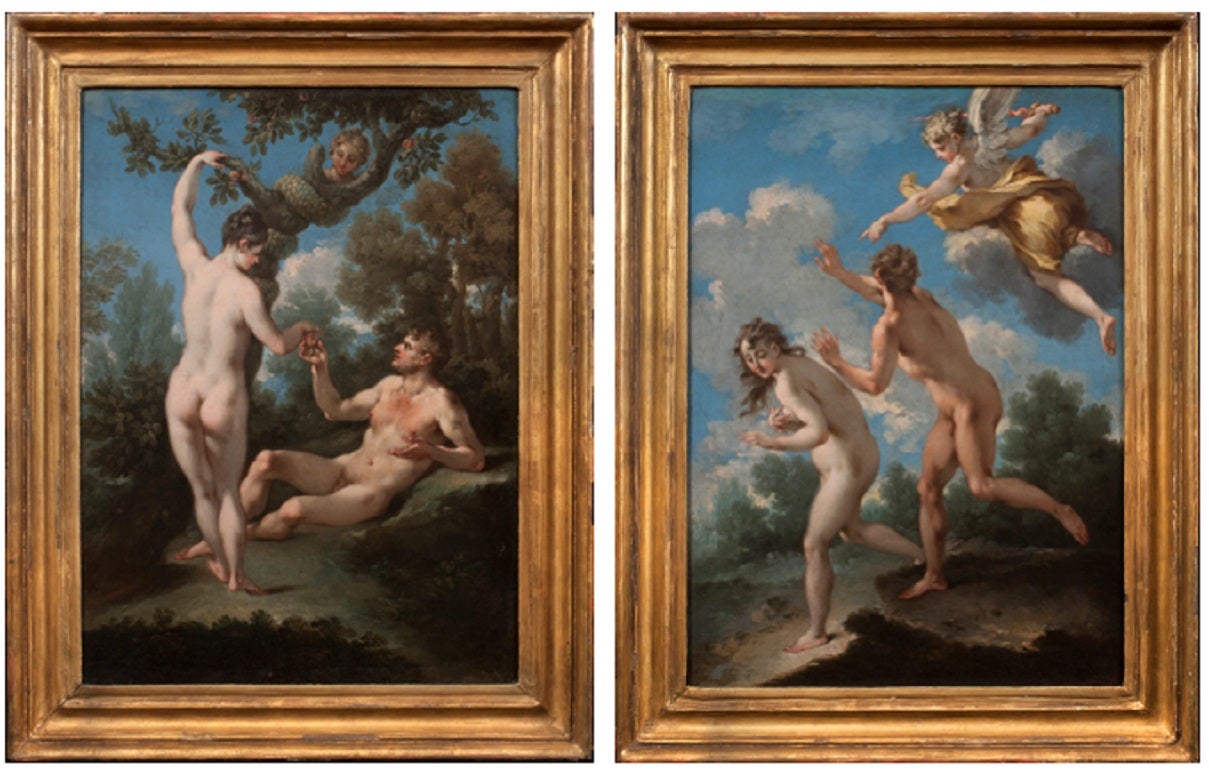
About the Seller
5.0
Recognized Seller
These prestigious sellers are industry leaders and represent the highest echelon for item quality and design.
Established in 1997
1stDibs seller since 2012
24 sales on 1stDibs
Typical response time: 7 hours
- ShippingRetrieving quote...Shipping from: New York, NY
- Return Policy
More From This Seller
View AllThe Three Magi
Located in New York, NY
Provenance: Private Collection, Spain.
Known as Peruvian alabaster for its translucency and workability, Piedra de Huamanga is a highly prized material from the province of Ayacucho in Peru. In the 17th and 18th centuries, local craftsman in the town of Huamanga began to specialize in the production of small-scale, polychrome religious sculptures made from this distinctive stone. Huamanga sculptures are among the most accomplished examples of carving from the Spanish Americas, where polychrome wood sculpture was a far more common sculptural medium. These works, which were created as independent sculptures or as sculptural groups—such as our three Magi—were intended for ecclesiastical as well as domestics settings.
Our three figures likely formed part of a larger Nativity group—a New World variant of the tradition of the Neapolitan Crèche...
Category
Late 18th Century Figurative Sculptures
Materials
Alabaster
First Journey
Located in New York, NY
Provenance: Sables de Fontainbleau, Seine-et-Marne, France
“Gogottes” are natural creations formed out of sands deposited in Northern France during the Oligocene Period, approximately 30 million years ago. Much later, in a process that has only recently become understood, groundwater rich in silica flowed through the sands...
Category
15th Century and Earlier Naturalistic Abstract Sculptures
Materials
Sandstone
Head of a Young African Man
Located in New York, NY
Provenance: Private Collection, Spain.
This intriguing and enigmatic sculpture depicts the head of a young African man emerging from a circular opening ...
Category
Early 1800s Figurative Sculptures
Materials
Terracotta
The Infant Saint John the Baptist with a Lamb
Located in New York, NY
Provenance:
James Byrnes, Los Angeles (1917-2011)
Giusto Le Court was born Josse or Justus de Corte in the Flemish city of Ypres. His father Jean was a sculptor and presumably his earliest training was with him before he entered the studio of Cornelis van Mildert. The young artist was clearly influenced by the dominant Flemish sculptor of the time, Artus Quellinus the Elder, with whom he may have worked on the decoration of the Amsterdam City Hall.
Following the lead of many northern artists he travelled to Rome, perhaps more than once, before settling in Venice around 1655. It was there, as one of a colony of expatriate artists, that he made his name as a sculptor. One of his first Venetian commissions was for the monument to Alvise Mocenigo in the Church of San Lazzaro dei Mendicanti, where Le Court sculpted the marble figures of Strength and Justice. He also collaborated with the celebrated architect Baldassare Longhena, most famously for the high altar of Santa Maria della Salute, where he carved the multi-figured altarpiece depicting the Queen of Heaven Expelling the Plague.
The present marble sculpture depicts the infant Saint John the Baptist, reclining, wearing his traditional hair-shirt, embracing a lamb, and holding the bottom of his attribute, a reed cross. Attached to his shirt is a baptismal cup, with which he would become associated later in his life. Veneration of the infant Saint John the Baptist was prevalent throughout Italy and images of the saint in childhood—often called “Giovannino,” or little John...
Category
17th Century Renaissance Sculptures
Materials
Marble
The Archangel Gabriel
By Cristobal de Villalpando
Located in New York, NY
Provenance: Private Collection, Cranston, Rhode Island (by the 1950s?); by family descent until sold at:
Bill Spicer Auction, North Kingstown, Rhode Island, 26 January 2011; where a...
Category
Late 17th Century Old Masters Figurative Paintings
Materials
Canvas, Oil
The Story of Joseph from the Second Baptistery Doors, Florence (“The Gates of Pa
By Ferdinand Barbedienne
Located in New York, NY
Ferdinand Barbedienne (Saint-Martin-de-Fresnay 1810 – 1892 Paris) after Lorenzo Ghiberti (Florence, 1378 – 1455)
Signed at the lower right of the principal relief: F. BARBEDIENNE
Provenance: Private Collection, USA.
Barbedienne’s “Gates of Paradise” reliefs are one of the triumphs of nineteenth-century bronze casting and patination. The nine panels that comprise our example are half-size reductions of the famous originals by Lorenzo Ghiberti, made for the Baptistery of Florence and now housed in the Museo del Opera del Duomo. Mounted in an impressive, mullioned frame surround, our work is an exceptional exemplar of the Renaissance Revival, the broadly influential style and movement that infused architecture, design, and artistic culture in the latter half of the nineteenth century.
The central scene, The Story of Joseph, is perhaps the most celebrated of the entire series depicting as it does seven episodes from the Biblical narrative integrated into a single composition: Joseph cast by his brethren into the well, Joseph sold to the merchants, the merchants delivering Joseph to the pharaoh, Joseph interpreting the pharaoh’s dream, the pharaoh paying him honor, Jacob sending his sons to Egypt, and Joseph recognizes his brothers and returns home. The surrounding reliefs—two vertical figures in niches, two recumbent figures, and four portrait heads in roundels—are as well faithful reductions of Ghiberti’s original bronzes on other parts of the doors.
The maker of these casts was the renowned 19th-century French fondeur Ferdinand Barbedienne. Gary Radke has recently written of this great enterprise:
“The Parisian bronze caster Ferdinand Barbedienne began making half-sized copies of ancient and Renaissance sculpture in the 1830s. His firm benefitted enormously from the collaboration of Achille Collas, whom Meredith Shedd has shown was one of numerous pioneers in the mechanical reproduction of sculpture. Their competitors largely devoted themselves to reproducing relief sculpture, but Collas devised a process for creating fully three-dimensional copies. A tracing needle, powered by a treadle, moved over the surface of a full-sized plaster cast or bronze of the original and triggered a complementary action in a cutting stylus set over a soft plaster blank…He signed an exclusive contract with Barbedienne on November 29, 1838, and won medals for his inventions in 1839 and 1844.
Barbedienne’s half-sized copies of the Gates of Paradise were famous not only for their fidelity to the original, but also for the way their gilding…suggested the glimmering surface that was hidden under centuries of dirt. Some critics even saw Collas’s and Barbedienne’s work as ‘philanthropic, an exemplary adaptation of industry to the requirements of art, the artist, the workers, and the public alike.’
At 25,000 francs, Collas’s and Barbedienne’s reduction of the Gates of Paradise was singularly more expensive than any other item for sale in their shop. All the reliefs, individual statuettes, and busts were cast separately and could be purchased either by the piece or as an ensemble. Fittingly, Barbedienne’s accomplishment earned him the Grand Prix at the 1878 Paris Exposition Universelle, along with numerous other medals.”
Three complete examples of the Barbedienne-Ghiberti doors are known. One, first installed in a chapel in the Villa Demidoff of San Donato near Pratolino, was later acquired by William Vanderbilt...
Category
Late 19th Century Figurative Sculptures
Materials
Bronze
You May Also Like
Rare American Bronze Sculpture “Princeton Tiger” by Alexander Phimister Proctor
By Gorham CO.
Located in Shippensburg, PA
ALEXANDER PHIMISTER PROCTOR
American, 1860-1950
"Princeton Tiger" (1910)
Dark-brown and autumnal patinated bronze signed in cast "AP PROCTOR 1912", "GORHAM CO FOUNDERS 0454 # 88" ...
Category
20th Century American Animal Sculptures
Materials
Bronze
Thomas Francois Cartier (1879-1943): Tiger
By Thomas Francois-Cartier
Located in Budapest, Budapest
Thomas François Cartier, born on January 3, 1879, in Marseille, France, and passing away on December 27, 1943, was a notable French sculptor celebrated for his masterful depictions o...
Category
Vintage 1920s Art Deco Animal Sculptures
Materials
Marble, Bronze
$5,390 Sale Price
20% Off
Bengal Tiger Sculpture
By Anthony Redmile London
Located in North Hollywood, CA
Bengal Tiger sculpture by Santini made of silver electroplated cast composite and mounted on wooden base.
Category
1990s Italian Hollywood Regency Animal Sculptures
Materials
Composition
$1,250
Painted Cast-Metal Tiger circa 1900
Located in SANTA FE, NM
Painted Cast-Metal Tiger
Continental School, circa 1900
8.75 x 19.5 inches
Ex. Collection Interior Designer Joseph Cicio
Born and raised in Brooklyn, New York, Joseph Cicio followe...
Category
Early 20th Century Academic Figurative Sculptures
Materials
Metal
$1,960 Sale Price
20% Off
Very Fine Carved Alabaster Figure of a Tiger
Located in Atlanta, GA
A very fine carved alabaster figure of a tiger
Dimensions:
D 10"
H 17"
W 33"
CW4544.
Category
20th Century Animal Sculptures
Materials
Alabaster
Roaring Lionness
Located in Gent, VOV
A fine quality, twentieth-century bronze model of a roaring lioness by Alberic Collin (Belgian 1886-1962). Prior to casting by the Valsuani foundry it w...
Category
1930s Art Deco Figurative Sculptures
Materials
Bronze
